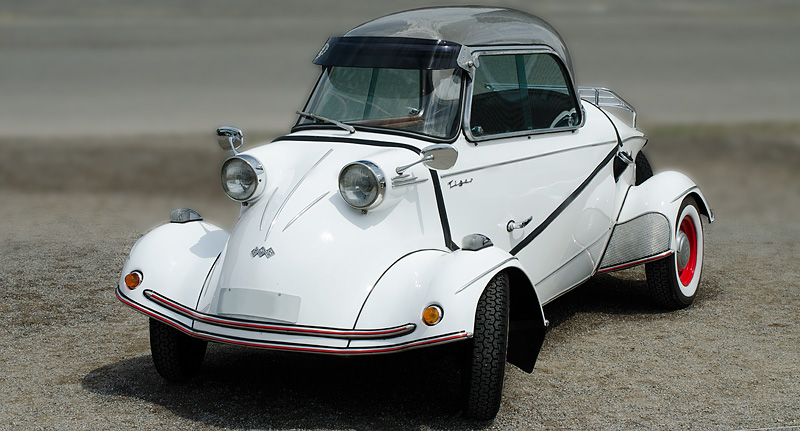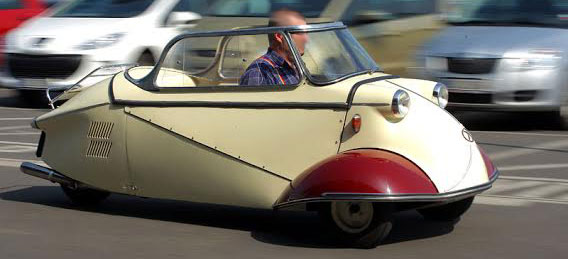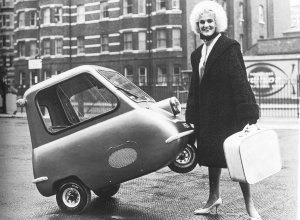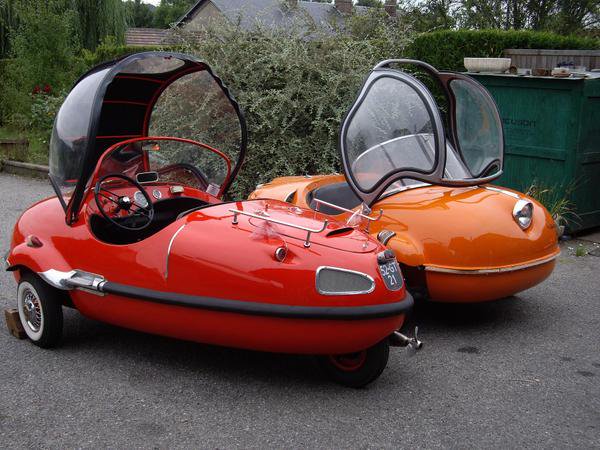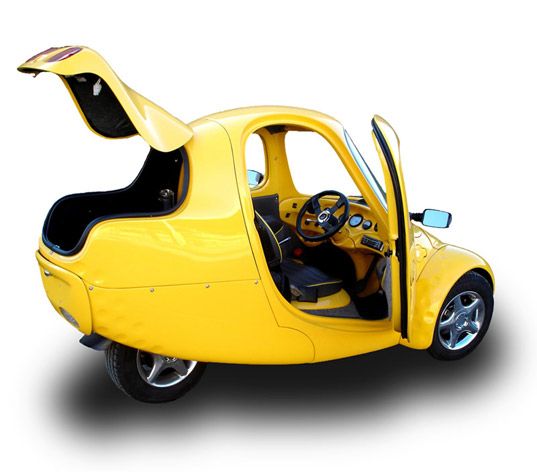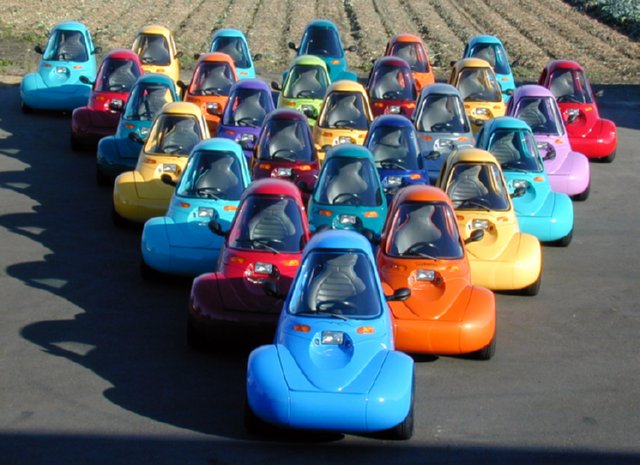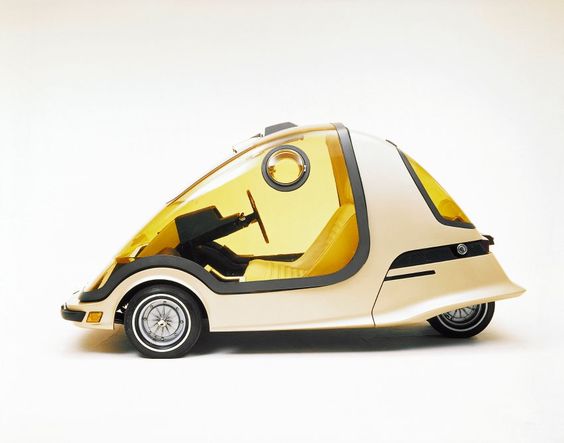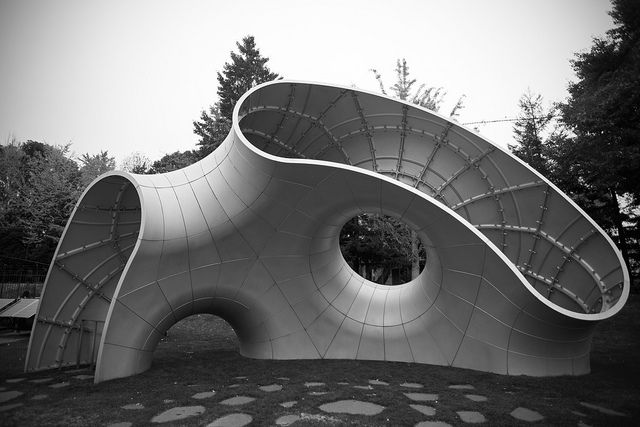Birth of the Messerschmitt (1950) Fritz Fend (1920-2000) Germany
Tricycle Tandem two-seat models
 |
 |
Messerschmitt AG was Germany's aircraft, Named in honor of the chief designer Willy Messerschmitt, and known mainly by the participation of Messerschmitt planes in World War II. The company survived after the war and was able to engage in the implementation of civil projects. Currently, the Messerschmitt company is part of the largest European EADS aerospace holding company. In the automotive industry, the Messerschmitt company had time to check in 50 years, when we created two-car tandem passenger models (the driver is located at the front and a passenger behind), KR175 and KR200. These micro-cars were built on the basis of “severe disabilities”.
1953 Messerschmitt KR-175
Messerschmitt (1954)

1953 Messerschmitt KR-175 are Models to 4 red the knife smear
The Messerschmitt KR 175 et KR 200 Kabinenroller are seater tricycles tandem vehicles built by Fritz Fend under the brand name Messerschmitt in the early 1950. The KR abbreviation is derived from the German word Kabinenroller (Scooter cabin). The number indicates the displacement (175 or 200 cm³).

MESSERSCHMITT TG 500 TIGER (1958)
Fritz Fend (1920-2000) was an aeronautical engineer. It was noted for the Messerschmitt design Kabinenroller (Cabinscooter) KR175 and KR200 microcars , for co-founder RMF, the company that took over the production Kabinenrollers 1956, and the design of the RMF TG500 , sports microcar based Kabinenroller. Fend continued his career as an inventor and designer of the end of production KR200. Fend working on another project light vehicle shortly before his death.
https://www.youtube.com/watch?v=mo7L5CYDOO0
The racing scene Messerschmitt KR200 Film Finnish musical "Iskelmäprinssi (Prince du Hit Parade) ».
US Air Force pilot with unusual Transport , Germany 1953
Historical
After the surrender of Germany at the end of World War II, the population was a large number of disabled people injured. The engineer Fritz Fend had worked during the war on the first jet fighter Messerschmitt Me 262. Despite threats from Morgenthau Plan (destroying the industrial fabric to transform Germany into a purely agricultural country), Fend began studying vehicles powered by muscle power.
A first series of specially designed vehicles for amputees legs was born in 1947. An arm lever operated the wheels. The first cart coachwork, named “'Streaker'” (trad. free : "Splits la bise") rolling in Rosenheim, proving that it is possible to go twice as fast by bike while being protected against the weather. In 1948, he rides a motor Victoria 38 cm³ and reached 40 km / h 1 ch. until September 1950, Fend sells 100 Copies of Flitzer. bicycle wheels had meanwhile been replaced by wheelbarrow tires wheels. The rear wheel remains a bicycle wheel. The cabin was transparent, tell Fend, both because of the narrowness of the vehicle for psychological reasons, and realized by using inflatable material for roofing. When the weather is nice, it became a cabriolet. until the end 1951, le 'Streaker’ Fend, equipped with a motor Riedel 4,5 hp and forced cooling, was made 150 copies. He could even climb the road to the summit of Grossglockner.
Messerschmitt KR 175
Due to lack of space, Fend looking for new premises. Thanks to Professor Willy Messerschmitt interceding on his behalf, it can use the empty hangars Society Regensburg Stahl- and metal (RSM). The only requirement is to make this vehicle a cart with two seats. The development work remain to Rosenheim. Willy Messerschmitt was a fanatical supporter of lightweight construction and its motto was : "Anything that does not break is oversized ! »
The noise that ran wherein the Kabinenroller, called Karo (recalling the abbreviated form of the name Karoline), would include elements of the famous hunter Me 109, was a real stunt. Aerodynamics, boarding by tilting the canopy Plexiglas, the two-seat tandem arrangement and the search for lightness are common with a plane.
At the Geneva Motor Show 1953, le KR 175 first appeared. Daily production was 90 copies. Its price amounted to 2 100 marks. It was gradually improved and equipped with a clutch in front and a reverse.
Given the very Sachs engine motorcycle technology 2 time, the reverse gear is unusual : A motor 2 time having a reversible direction of rotation (by means of a second pair of screws platinised suitably offset with respect to TDC of piston), while backing up with the KR necessary to stop the engine, then switch a dedicated switch to turn on the second set of breaker points and reverse the starter (actually a Dynastart, hybrid dynamo and starter, directly engaged with the crankshaft), before turning the engine running. Corollary of this assembly, it is possible to move all in reverse gear, some reckless drivers even fun to drive at full speed in the wrong direction…
Messerschmitt KR 200
In spring 1955, it was the turn of the KR 200 see the day. Sales this year reached 12 000 vehicles for a price of 2 500 marks. It was also the heyday. In the space of 24 h, it establishes no less 25 world records on the track of Hockenheim. Equipped with an engine 13 ch, he uttered tips 130 km / h !
1955 Messerschmitt KR200
1955 Messerschmitt KR 200 Cabriolet in “The Avengers”, TV Series (Emma Peel + John Steed)
(Season 4, Episode 17) The Girl from Auntie (1966)
Messerschmitt Tiger 500
seating: The lounge car has 2 seating. Messerschmitt Tiger was issued with the following body types: cut fixed head. Tiger car (1960) a 300 kg and this is the minimum weight among all modifications Messerschmitt Tiger. The heaviest car in a Messerschmitt Tiger Production Line, Tiger is the model (1960) – its weight 300 kg.The smallest model is Tiger (1960), making 2860 millimeters. The Messerschmitt is the longest Tiger model (1960), the length – the 2,86 meters. Messerschmitt Tiger was equipped with a single engine option whose volume is equal to 400 cc. The car Messerschmitt Tiger is equipped with a manual transmission only.
The 15 January 1957, Messerschmitt abandon all activities not related to aviation in order to receive government aid to support the reconstruction of an aerospace industry in Germany. The company Fahrzeug- and mechanical engineering Regensburg (from) (FMR) resumes production.
September 1957 : testing of a vehicle 4 wheels called Tiger conceived as successor "sport" model of tricycle. the TGR 500 is often named Tiger (Tiger) but this name is semi-official mark for paternity reasons : Indeed Krupp produced a truck model named Tiger Panhard and filed the name "Tiger" for all versions “inflated” its flat twin engine powering the Dyna Z , PL 17 and 24 Ct. The engine is this time a twin-cylinder 2T 500 cm3 always supplied by Fichtel und Sachs (in), installed in cantilever rear, it propels the Tgr 500 series to 130 Km/h, much more than contemporary popular car like the Citroën 2CV or 4 Renault CV of the time and almost as much as the small English sports car Austin-Healey Sprite. The passage 4 wheels requires the presence of a differential which is common housing with the gearbox. The reverse is this time mechanical (without reversing the rotation of the motor). The body remains very similar to the model 3 wheels, strict 2 seats in tandem, way motorcycle or jet fighter cockpit, while for example the Vespa 400 , comparable but more automotive appearance offers two mini rear seats for children. The fairing of the stern is extended and incorporates a spare wheel housing arranged in the manner of “continental kit” some American cars.
2 May 1958 : presentation of Tg 500. Its price 3650 Marks put off customers.
beginning 1964 : stop production due to non-profitability.
Classic Car | 1961 Messerchmitt KR200 | Driving.ca

Messerschmitt Tiger

FMR Tiger 500
the Messerschmitt : At the movie theater
La KR 175 is visible in the film Brazil Terry Gilliam, as well as in film The Addams Family wherein the cart is driven by itt cousin.
Excerpt from the film Brazil Trailer (1985) – Terry Gilliam 2:56
1 : 23 Brazil Bubble Car Dreaming
2 : 54 cousin Machin (cousin here) : the film Addams Family wherein the cart is driven by itt cousin.
Technical characteristics: KR 175 / 200
Overall dimensions : 2820 x 1220 x 1200 mm
wheelbase : 2030 mm
way (wheel spacing before) : 920 / 1080 mm
motor Fichtel & Sachs, single cylinder two stroke
Bore x stroke : 62 × 58 / 65 × 58 mm
Displacement : 173 / 191 cm³
Power : 9 / 10.2 ch 5250 tr/min
Compression : 6,5:1
Carburetor : 1 (marque Bing)
forced air cooling (fan)
Lubrication by mixing 1:25
Transmission
primary chain drive
Clutch : 3 / 4 discs in oil bath
Gearbox : 4 reports
reverse gear : absent on kr 175, by motor rotation direction is reversed on the KR 200
secondary transmission to the rear wheel under sealed casing string
Running gear
train before : half arm (broken axle)
rear axle : swinging arm
Suspensions by rubber blocks
hydraulic damping on the KR 200 only
pneumatic : 4,00″ × 8″ then 4.40 × 8″ (KR 200)
Direction
almost direct with bike-type motorcycle
Turning radius : 8 m
Electricity
generator 45 / 90 W
Drums : 6 V 7Ah / 12 V 14 Ah
highlight 25 / 35 W
Unloaded weight : 220 / 240 kg
Total weight : 360 / 420 kg
Top speed. : env. 80 / 98 km / h
Consumption : env. 4.0 / 4.5 l / 100 km
Tank : 11,5 / 12.5 liters (located above the engine)
Fabrication 1953 -1955 for the KR 175, from 1955 – 1964 for the KR 200

Messerschmitt KR Super 200 white 1955
Showing Messerschmitt museum Microcar now closed in History,
in Germany.

The Messerschmitt Kabinenroller (cabin scooter)
Was a three-wheeled bubble car designed by aeronautical engineer Fritz Fend and produced in the factory of the German aircraft manufacturer Messerschmitt 1953-1964.

3D – Messerschmitt KR200 Snowmobile
Microcar & Kabinenroller Club from Switzerland
Small Small car on Race GP Mutschellen 2010
Messerschmitt Tiger
Two Turkish directors Yılmaz Onay and Erol Keskin with a Messerschmitt in Turkey (1968)

In 1957, the KR200 Kabrio model released, with fabric hood and fixed side window frames. This was followed by the KR201 Roadster without a window frame., using a folding fabric top, a windshield and removable side curtains. A Sport Roadster was then offered without a roof and with the canopy fixed in place so the driver had to get on and off at the top of the car..
Messerschmidt KR201 was, just like Heinkel, a major aircraft manufacturer who specialized in the design of Bubble cars.
This KR201 was very popular at the end of the years 50 and in the early 60.
1958 Messerschmitt KR200
Microcars au Technik Museum Jesada –
While traveling through Thailand, we discovered le Technik Museum Jesada in a small town outside Bangkok. Home to more than 500 vehicles, including double-decker bus, planes, helicopters and scooters, the most unique attraction is the museum's vast collection carts. Also known as "bubble cars", These large refrigerator cars were built low because of limitations in the materials and resources in Europe after World War II. Retro models and progressive years 1950 microcars have become a model for the modern smart vehicle.
1957 Messerschmitt FMR Tg 500 Tiger
Messerschmitt KR 175
1954 Mivalino small car.
own Italian version motorcycle Mid Valley company Messerschmitt KR-175
1957, Messerschmitt KR 201 Roadster.


The factory produced aircraft during the war, after the war was used in production cars.
KR200-Reincarnation Classic Car Model
+ BONUS +
Peel microcars were built in Peel, Isle of Man in the years 1960 by Peel Engineering.


Motorist sitting in the Peel P50 the smallest car in the world !

Peel 50 is a small and atypical seater vehicle !
Discover some of these trade secrets.
https://youtu.be/lKw3digD3FM
Peel P50 – the smallest production car in the world, weighing just 130 books (59kg).
The smallest car in the world at the BBC – Top Gear – BBC
Jeremy drives Peel P50, the smallest production car in the world to work for the BBC and met some famous faces along the way.

Assorted ruffles

1964 Microcar
BONUS ! The PEA CAR

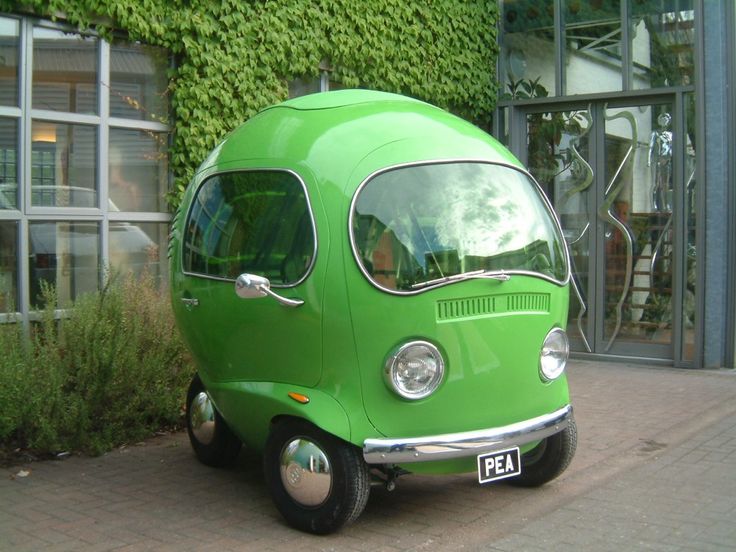
Car (car) Pea (Because) – Pub TV
L'E50 118 E50 is miles an electric car to be produced in China this year, for the Chinese market only.
The design is very similar to the Chevrolet Spark EV with four seats, it has a maximum speed 130 km / h for a range announced at 190 km thanks to its Lithium Iron Phosphate, fast charging (at 80%) tough 30 minutes (Amperage unspecified) And a full charge 8 hours on a conventional socket.
















